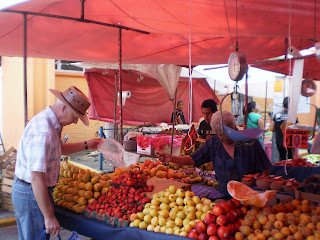
Pictured above is a view of the city from atop the Castillo in Chapultepec Park.

The city is a mixture of buildings
from the colonial era and the
modern. To the right is the Palace
of Fine Arts, an ornate building
inside and out. It includes a
theater, art galleries, and a
restaurant.
This is a view to the south of the Palace of Fine Arts that shows commercial buildings built in the colonial era.
This is a city of monuments, and fountains
A monument to Christopher Columbus and the early priests who came to "civilize" the inhabitants of Mexico
A monument to celebrate Mexico's independence from Spain.
There are many small parks, ponds, statues of important national figures dispersed around the city, especially in the commercial, governmental,
and educational centers of the downtown area.


These photos show some of the more modern parts of town. Attractive buildings, tree lined streets, parks, monuments, water features adorn these areas. Many of these areas have a European flavor.
Shopping in the city is a mix of large modern malls like you would find in large cities in the US, small specialty shops, restaurants, and large open markets selling food, household goods, clothes,and artisan shops selling native arts and crafts.

One observation is that there are few skyscrapers. I think there are two reasons for this. First, the city is in a serious earthquake zone. In 1985 a large earthquake destroyed large parts of the city and killed close to 100,000 people. Second, much of the city, down the hill from the more modern area we are now looking at, was built on a old lake bed and buildings there are constantly sinking. The area around the temple is on this lake bed. A great deal of technology and engineering is used to keep it level and to limit sinking.
The photo below shows some colorful apartment buildings and the horrendous traffic in Mexico City. The city has over 20 million inhabitants, 5 million cars, and an inadequate highway system.
Interestingly, there are over 120,000 taxis and a good metro system. The metro carries 5,000,000 passengers daily. We use the metro when we can because it is faster than going by taxi when traveling downtown. Normally the cars are filled to capacity. It is safe if you travel in daylight hours, but you must guard your valuables from pickpockets. When necessary we take taxis, they are cheap (a 10 minute ride will cost you 2 dollars), easy to find, and generally safe. I say generally, because there are few accidents, especially considering the lack of the use of traffic laws and the daring way they drive - it has to be experienced to be understood and believed - and since they license the taxis we use, assaults and robbery are rare. We've had no difficulty.

The Castillo at Chapultepec Park

The park is the largest in the city and contains world class museums, a zoo, large areas of grass, trees, bushes and flowers, and on top of a hill the Castillo. Above Leslie and Sergio, our taxi driver and guide walk up the hill to the Castillo. To the left, we are at the entrance.

The building began as a military academy for young men to prepare to be military officers. Later it was converted to the residence for the country's rulers and presidents. About 50 years ago it was converted to a museum with the first floor containing historical artifacts, and artistic representations of the country's development. The second floor shows how it looked when rulers and presidents lived there. The edifice is beautiful and elegant.

This was the dinning room for entertaining visiting dignitaries. It is elegant and opulent. Other parts of the living area give a good idea of how the wealthy lived a century ago. Pictured below is the rooftop garden area. It is spectacular in two regards: the gardens, statuary, buildings and patios are beautiful; and because of its location the view of the city is spectacular. The photo showing the overview of the city, at the beginning of this post, is taken from this rooftop area.
 Leslie and I are really happy you are visiting our mission blog. We are having a great time here in Mexico City and we are happy to share some of what we are experiencing with our family and friends. The posts below will give you an idea of where we work and live. If you are are a first time visitor, I suggest you start at the bottom of the blog and work from the bottom to the top, it will make more sense that way.
Leslie and I are really happy you are visiting our mission blog. We are having a great time here in Mexico City and we are happy to share some of what we are experiencing with our family and friends. The posts below will give you an idea of where we work and live. If you are are a first time visitor, I suggest you start at the bottom of the blog and work from the bottom to the top, it will make more sense that way.







































